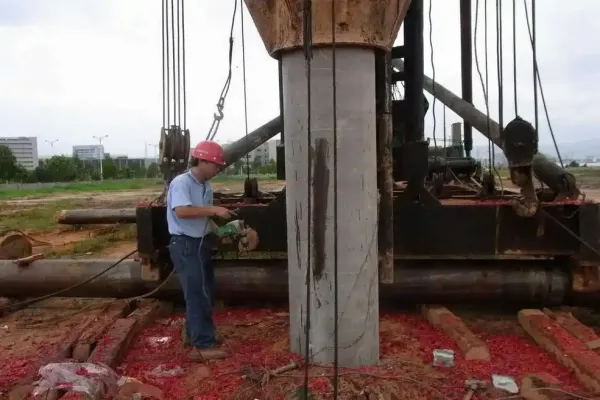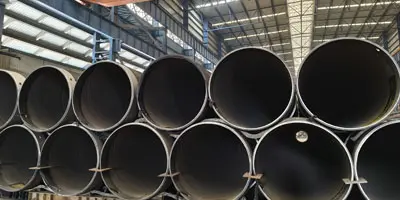When choosing a piling pipe, there are many types of steel pipes to choose from, such as seamless piling pipe and ERW pipe piling pipe, both of which have their own different characteristics, advantages and limitations. In this article, we will compare seamless and ERW piling pipes and explore their differences, advantages and ideal use cases to help you make an informed decision.
Piling pipe meaning
Steel pipe piles are products made of steel pipes, mortises, and tenons. Steel pipe piles overlap each other in an arc or circle, which can be used to surround water and sand, etc. They are mainly used in offshore docks. Steel pipe piles have the advantages of simple structure, convenient use, good sealing, high strength and good elasticity. Steel pipe piles come in a variety of sizes, with an outer diameter of 50-120cm and a wall thickness of 1-1.8cm. Piling pipes are mainly used in construction and infrastructure projects to support foundations, transfer loads and provide stability in soft or unstable soil conditions. They play an important role in deep foundation systems such as bridges, buildings and offshore platforms.
What is ERW steel pipe?
ERW steel pipe is a type of welded steel pipe like LSAW steel pipe and SSAW steel pipe. ERW (electric resistance welded) steel pipe is made by welding flat steel plates using high-frequency resistance heating. The steel plate is rolled into a cylindrical shape and then the edges are welded together. ERW pipe is known for its high cost-effectiveness, fast production speed and size versatility.

ASTM A252 Standard Overview
ASTM A252 is the standard specification covering nominal wall, cylindrical steel pipe piles. These pipes are primarily used for load-bearing purposes in construction, including buildings, retaining walls, bridges, ports, and more. The standard applies to both seamless and welded pipes, including ERW types.
Mechanical Properties
The mechanical properties of A252 piling pipe vary depending on the grade. The standard defines three grades, with Grade 3 offering the highest strength:
|
Property
|
Grade 1
|
Grade 2
|
Grade 3
|
|
Tensile Strength, min
|
50,000 psi (345 MPa)
|
60,000 psi (415 MPa)
|
66,000 psi (455 MPa)
|
|
Yield Strength, min
|
30,000 psi (205 MPa)
|
35,000 psi (240 MPa)
|
45,000 psi (310 MPa)
|
These values ensure that the steel piles can handle substantial structural loads under demanding environmental conditions.
Chemical Composition
For both seamless and ERW A252 steel piles, the maximum phosphorus content is limited to 0.050%, to control embrittlement and enhance weldability. This contributes to better performance during pile driving and under long-term load-bearing use.
Testing and Quality Control
Although hydrostatic testing is not required, mechanical tests are performed to ensure material integrity and consistency. Each manufacturing batch undergoes tensile testing, which can be conducted in either the longitudinal or transverse direction at the manufacturer's discretion.
Tensile Test Frequency: One test for every 200 lengths of pipe.
Dimensional Tolerances
To maintain reliability and structural performance, ASTM A252 sets strict limits for permissible variations:
Wall Thickness: Not more than 12.5% under the nominal thickness.
Weight per Foot: Pipe weight must not exceed +15% or -5% of theoretical calculated weight.
Outside Diameter: Must be within ±1% of the specified diameter.
These tight tolerances ensure uniformity across each batch, which is essential for seamless construction and pile driving operations.
Advantages of ERW Piling Pipes
1.ERW steel piling pipes have become the preferred choice for many contractors and engineers due to the following benefits:
2.Consistent Quality: The high-speed ERW manufacturing process ensures minimal variation in wall thickness and weld seam integrity.
3.Cost-Effective: ERW pipe production is more efficient and less expensive than seamless methods, offering excellent value for large-scale projects.
4.Excellent Structural Strength: With the availability of Grade 3 material, ERW piling pipes can handle heavy loads, making them suitable for demanding projects like deep foundations and heavy civil infrastructure.
5.Customizability: Pipes can be tailored in terms of diameter, wall thickness, length, and end type based on project specifications.
6.Weldability: Low phosphorus content and clean welding profiles improve the ease and durability of welding during installation.
Applications of ERW Piling Pipes
ERW piling pipes are used in a variety of construction and civil engineering applications, such as:
Foundation piling for buildings and bridges
Retaining walls and cofferdams
Marine construction, docks, and piers
Load-bearing columns in deep soil conditions
Temporary or permanent earth retention systems
Their ability to withstand axial and lateral loads while maintaining structural integrity in harsh soil or water environments makes them invaluable to modern infrastructure.






 English
English Español
Español بالعربية
بالعربية











 Phone :
Phone :  Whatsapp :
Whatsapp :  Email :
Email : 


